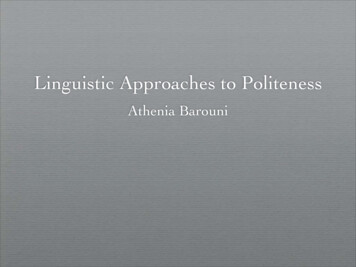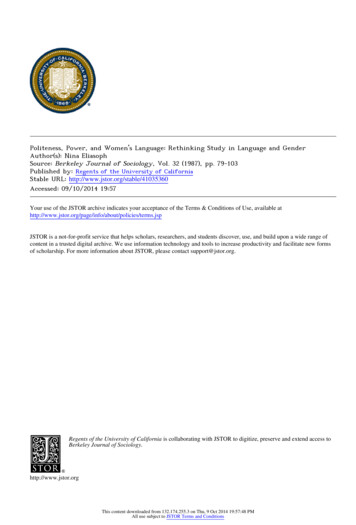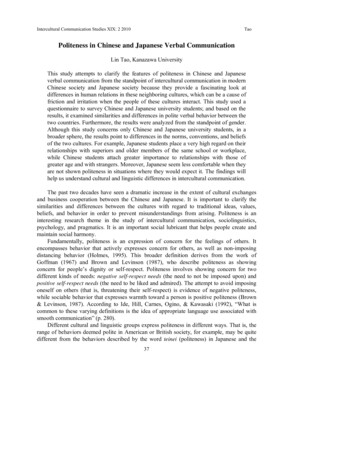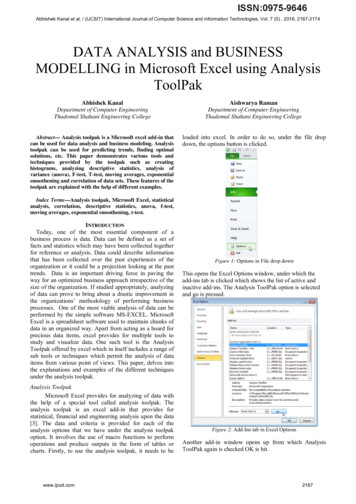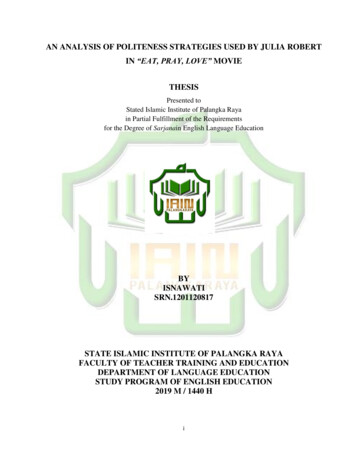
Transcription
AN ANALYSIS OF POLITENESS STRATEGIES USED BY JULIA ROBERTIN “EAT, PRAY, LOVE” MOVIETHESISPresented toStated Islamic Institute of Palangka Rayain Partial Fulfillment of the Requirementsfor the Degree of Sarjanain English Language EducationBYISNAWATISRN.1201120817STATE ISLAMIC INSTITUTE OF PALANGKA RAYAFACULTY OF TEACHER TRAINING AND EDUCATIONDEPARTMENT OF LANGUAGE EDUCATIONSTUDY PROGRAM OF ENGLISH EDUCATION2019 M / 1440 Hi
ii
iii
iv
MOTTO AND DEDICATION“And whoever strives only strives for [the benefit of] himself.Indeed, Allah is free from need of the worlds.”(Q.S. Al-Ankabut: 6)This Thesis is dedicated to:My beloved Father Nanang, my beloved MotherSiti Suharni, my beloved cousin Trisnayanti,Wirnawati, and Harsiance. For their valuableendless prayer, material, time, sacrifice, patientand support. Thank you very much.v
vi
ABSTRACTIsnawati. 2019. An Analysis of Politeness Strategies Used by Julia Robert in“Eat, Pray, Love” Movie. Thesis, Department of Language Education,Faculty of Teacher Training and Education, State Islamic Institute ofPalangka Raya. Advisors: (I) Dr. Imam Qalyubi, M.Hum., (II) ZaitunQamariah, M.Pd.Keywords: politeness strategies, hedges, movie.One of the basic requirements in communication with others is politenessstrategy. In other words, in every communication there is a possibility of threats toface of both interlocutors. In hedges, people tend to use strategies in maintainingother‟s face that show degree of politeness.The objectives of this research are(1) to describe the types of hedges that areused by Julia Robert as main character in “ Eat, Pray, Love” movie and(2) todescribe the functions of Julia Robert as main character in “Eat, Pray, Love”movie use hedges in communication.The research design of this study is qualitative descriptive. The data werethe utterances spoken Julia Robert in “Eat, Pray, Love” movie. This study wascarried out by formulating problem, collecting data, classifying data and analyzingdata. Meanwhile, the documentation was used as techniques of data collection.The results of this research can be seen as follows. First, there are 5 (five)types of hedges out of seven types found out by the researcher in her data. The 5(five) types of hedges used by Julia Robert in “Eat, Pray, Love” movie are modalauxiliary verbs which consist of 9 (nine) data, modal lexical verbs which consistof9 data, adjectival, adverbial and nominal modal phrases which consist of2(two) data, approximator degree of quantity, frequency, and time which consist of4 (four) data, and introductory phrases which consist of 1 (one) data.The researcher concludes that modal auxiliary verbs and modal lexical verbis the most frequently used type of hedges by Julia Robert and the least are ifclauses and compound hedges because Julia Robert does not use it in hisutterances. Regarding this fact, it has been concluded that the way the maincharacter used hedges is to apply expression of doubt and confidence, sensitivityother‟s feelings, and searching for the right word. The use of hedges by the maincharacters “Eat, Pray ,Love” movie obviously gives a clear description related topoliteness strategy in having conversation in social context.vii
ABSTRAKIsnawati. 2019. Sebuah Analisa Strategi Kesopanan Dalam Fim “Eat, Pray,Love” oleh Julia Robert.Skripsi, Jurusan Pendidikan Bahasa, FakultasTarbiyah dan Ilmu Keguruan, Institut Agama Islam Negeri Palangka Raya.Pembimbing: (I) Dr. Imam Qalyubi, M.Hum., (II) Zaitun Qamariah, M.Pd.Kata Kunci: strategi kesopanan, penggunaan bahasa secara lebih sopan, film.Salah satu syarat dasar ketika berkomunikasi dengan orang lain adalahstrategi kesopanan. Dengan kata lain, dalam setiap komunikasi ada kemungkinanrasa tidak nyaman terhadap lawan bicara. Dalam penggunaan bahasa secara lebihsopan ( hedges), orang cenderung menggunakan strategi dalam melindungi wajah( menjaga martabat) orang lain yang menunjukkan tingkat kesopanan.Tujuan dari penelitian ini adalah (1) untuk menggambarkan penggunaanbahasa secara lebih sopan (hedges) yang digunakan oleh Julia Robert sebagaikarakter utama dalam film “Eat, Pray, Love” dan (2) untuk mengambarkan fungsiJulia Robert sebagai karakter utamamenggunakan penggunaan bahasa secara lebihsopan (hedges) dalam film “Eat, Pray, Love”.Penelitian ini menggunakan deskriptif kualitatif. Data adalah ucapan-ucapanyang diucapkan Julia Robert dalam film “Eat, Pray, Love”. Penelitian inidilakukan dengan merumuskan masalah, mengumpulkan data, mengklasifikasikandata dan menganalisis data. Sementara dokumentasi digunakan sebagai teknikpengumpulan data.Hasil penelitian ini dapat dilihat sebagai berikut. Pertama, ada lima jenispenggunaan bahasa secara lebih sopan (hedges) dari tujuh jenis yang ditemukanoleh peneliti dalam datanya. Lima jenis penggunaan bahasa secara lebih sopan(hedges) yang digunakan oleh Julia Robert dalam film “Eat, Pray, Love” adalahkata kerja modal tambahan yang terdiri dari 9 (sembilan) data, modal leksikal 9(sembilan) data, kata sifat, kata kerja modal nominal dan nominal 2 (dua) data,derajat perkiraan kuantitas, frekuensi dan waktu 4 (empat) data, dan frasapengantar 1 (satu) data.Peneliti menyimpulkan bahwa modal bantu kata kerja dan modal leksikaladalah jenis penggunaan bahasa secara lebih sopan (hedges) yang paling seringdigunakan oleh Julia Robert . Julia Robert tidak menggunakan jika klausa danpenggunaan bahasa secara lebih sopan (hedges) majemuk dalam fim “Eat, Pray.Love”. Mengenai fakta ini, telah disimpulkan bahwa cara karakter utamamenggunakan penggunaan bahasa secara lebih sopan (hedges) adalah untukmengekspresikan keraguan dan kepercayaan diri, kepekaan terhadap perasaanorang lain, dan mencari kata yang tepat. Penggunaan bahasa secara lebih sopan(hedges) oleh karakter utama film "Eat, Pray, Love”jelas memberikan gambaranyang jelas terkait strategi kesopanan dalam berbicarapadakonteks sosial.viii
ACKNOWLEDGEMENTSThe researcher would like to express her sincere gratitude to Allah SWT.,for the blessing bestowed in her whole life particularly during the thesis writingwithout which this thesis would not have come to its final form. Sholawat andsalam always be bestowed to the last prophet Muhammad SAW., having shownus the role of life to make our life true.Her appreciation is addressed to:1. Dr. H. Kharil Anwar, M.Ag as the Director of IAIN Palangka Raya for hisdirection and permission of conducting this thesis.2. Dean of Faculty of Teacher Training and Education of the State IslamicInstitute of Palangka Raya, Dr.Hj.Rodhatul Jennah, M.Pd., for her invaluableassistance both in academic and administrative matters.3. Chair of Department of Language Education, Santi Erliana,M.Pd., for herinvaluable assistance both in academic and administrative matters.4. Chair of Study Program of English Education, M.Zaini Miftah, M.Pd.,for hisinvaluable assistance both in academic and administrative matters.5. Thesis advisors, Dr. Imam Qalyubi , M.Hum., as advisor I and ZaitunQamariah,M.Pd.,as advisor II for their generous advices,valuable guidancesand elaborated corrections during their busy times to the completion of herthesis.ix
6. All lecturers of Study Program of English Education for their valuableknowledge and supports.7. All of Study Program of English Education, especially the2012 batch, for theirsupports in sadness and happiness during the study in under graduate programand for their spirits to accomplish my study.8. Beloved parents, Mr.Nanang and Mrs. Siti Suharni for their moral support andendless prayer so that she is able to finish her study. May Allah SWT blessthem all. Aamiin.The researcher hopes this thesis can give some benefits for the readers.The researcher also realized that this thesis is still far from being perfect,therefore some constructive critics and suggestions are warmly welcome.Hopefully, may Allah SWT, always keep us on the straight path and reward usfor what we have done and this could be useful for all of us.Palangka Raya,May 05th2019The Researcher,Isnawati1201120817x
TABLE OF CONTENTSPageCOVER.iCOVER (Second Page) .iiADVISOR APPROVAL .iiiOFFICIAL NOTE .vTHESIS APPROVAL . viiMOTTO AND DEDICATION . viiiDECLARATION OF AUTHORSHIP .ixABSTRACT .xABSTRAK (Indonesian) .xiACKNOWLEDGEMENT . xiiTABLE OF CONTENTS . xivLIST OF TABLES . xviLIST OF APPENDICES . xviiLIST OF ABBREVIATIONS . xviiiCHAPTER ICHAPTER IIINTRODUCTION.1A.Background of the Study .1B.Research Problems.5C.Objectives of the Study .5D.Scope and Limitation .5E.Significance of the Study .6F.Definition of Key Terms .6REVIEW OFRELATED LITERATURE .8A.Previous Studies.8B.Language. 13C.Sociolinguistics . 14D.Speech Act . 15E.Politeness Strategy . 16xi
F.G.1.Bald on record. 172.Off-record . 173.Positive Politeness . 174.Negative Politeness. 17Hedges . 181.Definitions of Hedges . 182.Classifications of Hedges . 193.Functions of Hedges . 24Movie . 261. Definition of Movie.262. Kinds of Movie.263. Synopsis of “Eat, Pray, Love ” Movie. 29H.CHAPTER IIICHAPTER IVCHAPTER VConceptual Framework.29RESEARCH METHOD . 31A.Research Design . 31B.Source of Data . 32C.Time of the Research . 32D.Research Instrument . 33E.Data Collection Procedures . 35F.Data Analysis Procedures . 35G.Data Endorsement . 36RESEARCH FINDINGS AND DISCUSSION . 38A.Data Presentation . 38B.Research Findings . 41C.Discussion . 42CONCLUSION AND SUGGESTION . 63A.Conclusion . 63B.Suggestion. 64REFERENCES .APPENDICES .xii
LIST OF TABLESTablePage3.1Classification of Utterances used by Julia Robert . 334.1Data Findings . 384.2Research Findings . 41xiii
LIST OF APPENDICESAppendix1.Movie Poster2.Data Transcription3.Sites to Download4.Curriculum Vitaexiv
LIST OF ABBREVIATIONSMAMLVAANAPPIPIFCH:::::::Modal Auxiliary VerbsModal Lexical VebsAdjectival, Adverbial. And Nominal Modal PhrasesApproximators of Degree, Quantity, Frequency, And TimeIntroductory PhrasesIf ClausesCoumpound Hedgesxv
1CHAPTER IINTRODUCTIONIn this chapter, the writer discusses background of the study, research problem,objectives of the study, limitation of the study, significance of the study, and definitionof key terms.A. Background of the StudyCommunication has an important role in our life. According to Gartside,communication is the art of sharing anything. In its vital sense it means a sharing ofideas and feelings in a mood mutual understanding (1986:1). Thus, people cancooperate with each other when they communicate just as they do in any othershared activity. Communication is usually defined as conversation, namely forsending and receiving message. If the message cannot be received it means thatcommunication does not work well. In order to make communication run inharmony, the hearer should know the speaker‟s aim. Moreover, every day we adaptour conversation to different situations. Among our friends, for instance, we caneasily say something that would be seen discourteous among strangers and we avoidover formally with our friends. In both situations above we try to avoid making thehearer embarrassed and uncomfortable People generally who behave in accordancewith their expectation concerning their public self-image or face want to berespected.Face means public self-image of a person; it refers to the emotional and socialsense of self that everyone has and expects everyone to recognize (Yule, 1996:60).1
2Face has two aspects, positive and negative. An individual‟s positive face isreflected in his or her desires to be liked, approved of, respected of and appreciatedby others. While an individual‟s negative face is reflected in the desire not beimpeded or put upon, to have the freedom to act as one chooses (Thomas,1995:169). Therefore, people in their relationship need to preserve both kinds offaces for themselves and the people they interact with the politeness utterances.According to Brown and Levinson (1987:65), certain kinds of acts intrinsicallythreaten face, namely those acts that by their nature run contrary to the face wants ofthe hearer and / or of the speaker .When people talk, generally they only know aboutthe explicit meaning or information that is being exchanged between the speaker andinterlocutor. It is important to know that there is another concern related to theintention of speaker in his utterances, namely, the implicit meaning or interpersonalmessage of communication. In other words, when we speak, our words do not onlyconvey meaning but also carry interpersonal messages as well. Interpersonalmessage means the intention of the speaker by saying particular word towardsinterlocutor. In conveying interpersonal message in spoken interaction, the speakeris supposed to be polite with the appropriate etiquette in speaking and well-chosenwords in order to make the participant of the communication to feel comfortable andenjoy the conversation. But, in fact many people still lack knowledge of usingpoliteness strategy in their conversation. It was shown when the researcher attendeda sociolinguistics class, there were many university students who still lackknowledge of using politeness strategies especially about hedges.
ctedbasedsomesociolinguistic elements. As we know, sociolinguistic concerns with society andlanguage. Language that is used by certain people is different from others, it isaffected by many factors that influence and make a language different from onelanguage to others. The socioeconomic factor is one of various factors that influencewhy language varies. This factor makes a speaker who has lower level tends to speakmore politely to a higher level speaker. However, being polite is better not only usedin particular occasion, but also in general occasion when people have conversationwith every person.One of the reasons why people should be polite is if the addresser does not speakpolitely to the addressee, the utterances of the addresser may be misinterpreted by theaddressee. Generally, people will speak politely to whom they have a close relationwith or at least can be as their family. In this study, as the speaker is delivering hisutterance, he arranged it in a polite way using politeness strategies. Hedges are toolswhich belong to politeness strategies that can make the utterance of the speaker to bemore polite. Hedges which belong to politeness strategies become one of alternativeways that people should know as a speaking technique. People use hedges to showthat they are full of confidence or show they doubt toward statement given in order tomake the utterances more acceptable to the other people. According to Brown andLevinson (1987:61), politeness strategies are developed in order to save „face‟. Theconcept of face in social interaction was first introduced by Goffman in 1960s andwas further developed by Brown and Levinson in 1970 and 1980s. Brown and
4Levinson‟s theory of politeness includes the notion of face which is something that isemotionally invested, and that can be lost, maintained, or enhanced, and must beconstantly attended to in interaction‟.This study deals with the above issues. Specifically, it deals with the way howpeople convey interpersonal message in a conversation. One way of conveyinginterpersonal message is by hedging. As we know, hedge is such a device to make anutterance to be softer than it is without using it. That is why researcher tries to revealthe hedges used by Julia Robert in “Eat Pray Love” movie and the reason of using itin her utterances in “Eat Pray Love”movie. “Eat, Pray, Love” movie is theromance story which tells us about Liz Gilbert (Julia Robert) had everything asmodern woman and she is supposed to dream having-a husband, a house, and asuccessful career.The researcher choses this movie since the story of this movie conducted in thefour countries, in which one of them is in Bali (Indonesia). There were lot ofconversations that contained hedges. Julia Robert acts as the main character “Eat,Pray, Love” movie. The movie that the people talked most talked is Julia Robert.The researcher only focuses on researching what is said by Julia Robert compared tothe supporting actor because the researcher wants to know and describe thepoliteness strategies used by Julia Robert so that she can get the data and their uses.It happened when Julia Robert met people in different countries while she travelingsuch as Italy, India, and Bali. Julia Robert uses hedges when she has madeconversation with new friends because she knows that she is talking with her friends
5whose different cultures, so she is aware that she should be polite when talking withher friends. Besides, she also used hedges when having conversation with otherpeople in the different countries. That is why the researcher chooses “Eat, Pray,Love” movie as topic of her research.B. Research ProblemBased on the description above, the researcher conducts a study dealing with thetopic. The problems of this research are formulated below:1. What are the types of hedges used by Julia Robert in “Eat, Pray, Love” movie?2. What are the functions of Julia Robert to use hedges in “Eat, Pray, Love”movie?C. Objective of the StudyBased on the problems formulation above, the objectives of the study are statedas follows:1. To describe the types of hedges that are used by Julia Robert in “Eat, Pray,Love” movie.2. To describe the functions of Julia Robert to use hedges in “Eat, Pray, Love”movie.D. Limitation of the StudyIn this present research, the researcher only focuses on hedges as politenessstrategies used by Julia Robert in “Eat, Pray, Love” movie. It deals with negativepoliteness and utterance based on Salager classification of hedges. The researcherlimits the discussion on analyzing hedges because the researcher wants to find out
6and describes hedges used by Julia Robert in “Eat, Pray, Love” movie, so that shemight obtain the data about hedges and its uses.E. Significance of the StudyThe findings of this research are hoped to give contribution to English teachers,students, and other researchers.1. Theoreticallya. The result of this research could be used as source of reference, teachingSociolinguistics, especially about hedges.b. The research findings can contribute to students to know about hedgesalong with its categorization so that they are capable of using them whenthey are having conversation in order to facilitate turn-taking, showpoliteness, and mitigate face-threats.2. Practicallya. This research can stimulate other researchers to conduct a research in thefield of Sociolinguistic, especially about hedges.b. This study can be used as a reference for further researchers.F. Definition of Key TermsAccording to Brown and Levinson (1987:61), politeness strategies aredeveloped in order to save „face‟. The concept of face in social interaction was firstintroduced by Goffman in 1960s and was further developed by Brown andLevinson in 1970 and 1980s. Brown and Levinson‟s theory of politeness includes
7the notion of face which is something that is emotionally invested, and that can belost, maintained, or enhanced, and must be constantly attended to in interaction‟.Hedges are able to make communication euphemistic, moderate, polite andflexible, which effectively helps to maintain and adjust the relationship betweenspeaker and hearers and keep communication to be softer or less threatening.Movie is sequence of photographs projected onto a screen with sufficientrapidity as to create the illusion of motion and continuity. A movie is also definedas a connected cinematic narrative represented in this form. Its purpose is to certainits audience because it enacts the story by sound and a sequence of images givingthe illusion of continuous movement or visual effect.
8CHAPTER IIREVIEW OF RELATED LITERATUREIn this part, the writer presents theories relevant to language, Sociolinguistic,speech act, politeness, hedges “Eat Pray Love” movie review of previous studies andconceptual framework.A. Previous StudiesIn this part, the researcher would review some previous studies related to thistopic of research. The first research was the thesis entitled “the hedges Used byRonnie Miller and Steve Miller during summer Holiday in The Last Song Movie”written by Unola in 2013. The research focused on two points, namely types ofhedges and function hedges.After doing the research, she found that there were seven types hedges basedon Salager- Meyer classification (1997). There were: Modal auxiliary (MA), Modallexical verb ( MLV), adjectival, adverbial, and nominal modal phrases ( Probabilityadjective ( PA), Nouns (N), Adverbs ( ADV), Approximations of degree, quantity,frequency and time (APP), Introductory phrases ( IP), “ if clauses,” Compoundhedges ( CH).As the result, the most frequently used hedge was “if” clauses.” The secondwas Modal auxiliary, followed by Approximators of degree, quantity, frequently,frequency and time (APP), Adverbs ( ADV). The rest were Modal lexical verb andcompound hedges (CH). It was also found particular hedges well that could not becategorized in the types.8
9Meanwhile, in defining the function using Coates‟ theory, it was found thatthere were three functions of hedges used; expression of doubt, sensitivity ofothers‟ feeling, and searching for the right word. It revealed that the most frequentfunction was expression of doubt, followed by searching for the right word,expression of confidence and sensitivity of others‟ feeling as the lowest. The resultexplained that each function has close frequency of occurrence.The second research was the thesis entitled “Hedges Seen in the MainCharacters of the King‟s Speech Movie” written by Fauzi in 2012. The researchfocused on two points, namely categorization of hedges and the frequency use ofhedges. He used and combined the categorization of hedges that were proposed bySalager–Meyer (1997) and Sukarni (2007). In Salager- Meyer‟s classifications,types of hedges consist of seven types of hedges as have been mentioned above.While in Sukarni‟s types of hedges included lexical verb, adverbials, words thatconvey the truth of a statement, modal verbs, adjectives, modal noun. Besides,hedges are also combined with the used of emphatics and strong word.The result showed that were 124 (one hundred and twenty four) utterancescontaining hedges uttered by the four main characters of the King‟s Speech Movie.There were 7 (seven) kinds of hedges used by the main characters, they were modalauxiliary verb (67.7%); if –clause (14.5%); modal lexical verb (6.5%); strong words(4.8%); hedges combined with the use of emphatics (3.2%); approximator ofdegree, quantity, frequency, and time (0.8%); adjectival, adverbial, and modal nounphrase (2.4%).
10The third research was the thesis entitled “ An Analysis Politeness Strategyused by Stephen Hawking in “ The Theory of Everything” movie. The objectives ofthis research were to describe the hedges that were used by Stephen Hawking in“The Theory of Everything” movie and to find out the reasons of Stephen Hawkingin “ The Theory of Everything” movie.This research applied discourse analysis. The data were the utterances spokenStephen Hawking in “The Theory of Everything” movie. The results of thisresearch can be seen as follows. First, there were 6 (six) types of hedges out ofseven types found out by the researcher in his data. The six types of hedges used byStephen Hawking in “ The Theory of everything” movie were modal auxiliaryverbs (30%), modal lexical verbs (12,5%), adjectival, adverbial and nominal modalphrases (5%), approximator degree of quantity, frequency, and time (12,5%).The fourth research was the thesis entitled “ A Study of Politeness Strategiesused by the Characthers of the Ugly Truth Movie. In this research, The Ugly Truthmovie is chosen as the object. It was done to answer the problems of the research,they are: (1) What types of politeness strategies are used by the characters in TheUgly Truth movie? and (2) What are the factors influencing the choice of strategiesused by the characters in The Ugly Truth movie?The method that was used in this researchwas qualitative and content ordocument analysis as the type of study. The data of this research were the selectedutterances by the characters in the The Ugly Truth movie. There were 12 (twelve)dialogues used by 5 characters in the movie that analyzed as the object.
11The results of this research showed that there were 12 (twelve) utterances usingpoliteness strategies, consist of Bald on Record Strategy, Positive PolitenessStrategy, Negative Politeness Strategy, and Off Record Strategy. Each strategyconsists of three examples. The factor that influenced the different politenessstrategy consisted of three factors, social distance, relative power, and absoluteranking. The data showed that the social distance is the most used as the factor thatinfluenced the different politeness strategy.The fifth research was the thesis entitled “An Analysis of Positive PolitenessStrategy in the film entitled“In Good Company”. This research deals withPragmatics approach. It was a descriptive qualitative study, and it employedpurposive sampling as the sampling technique. The data were all the dialogscontaining positive politeness strategy which have significant relationship with theproblem statements. There were 29 (twenty nine) data found in the film. The datawere then identified by using Brown and Levinson‟s politeness strategy to answerthe kinds of positive politeness strategy employed by the character. The researcherused Brown and Levinson‟s politeness scale to find out the factors influencing thecharacters to employ those strategies.The results of the analysis showed that there were 15 (fifteen) strategies ofpositive politeness employed by the characters in the dialogs of film entitled “InGood Company.” Among them are notice, attend to the hearer (4 data), exaggerate(1 datum), intensify interest to the hearer (1 datum), use in-group identity markers(4 data), seek agreement (1 datum), avoid disagreement (5 data), presuppose / raise/
12assert common ground (2 data), joke (4 data), assert or presuppose the speaker‟sknowledge and concern for the hearer‟s wants (1 datum), offer / promise (1 datum),be optimistic (1datum), includes both the speaker
used by Julia Robert as main character in “ Eat, Pray, Love” movie and(2) to describe the functions of Julia Robert as main character in “Eat, Pray, Love” movie use hedges in communication. The research design of this study is qualitative descriptive. The data were the utterances spoken Julia Robert in “Eat,




